#China Scaffolding Market
Text

You know how I love offbeat properties and I found this seller's For-Sale-By-Owner ad on Zillow. He started building the home in 1969, in Eureka, California, and it's been under construction for 43 years! It's a French ornamented cathedral Gothic, with all custom ornaments, molds and scaffolding techniques. This mansion is based on Newport, Rhode Island style and spirit from the 19th Century.

This is what it's supposed to look like - The Vision.


And, in 43 yrs., this is what he's done so far. He's asking $4.5M. Now, he has been living in it, so you can live in the finished part. The house is being sold furnished, and what furnishings! Read what he wrote about them below:

"Also for sale here are 1500 sq. ft of the ultimate grade palatial antique Italian marquetry, veneer and solid wood furniture, ranging from console tables and mirrors; 10 different sizes of round antique tables, up to a 12' x 6' museum-piece dining table, various rare cabinets, marquetry, upholstered chairs, couches, china and other cabinets, solid gold (plated) grandfather clock and two huge antique chandeliers, all worth over $300k on the market now and arguably TWICE that!"

This outer door is amazing.

Here's a gargoyle and other ornamentation that still has to go on the house.

But, look at this - it says the exterior designs are ready for installation "when the lawsuit is over." So, the property is involved in a lawsuit, too? (Check the blog - I found the lawsuit papers and posted it.)

There's so much stuff here.

This room is done. It must be a ballroom. I don't know what to make of all this. This looks like the Romanoff's place.

This must be a music room. There's a harpsicord and a harp in here.

Look at these walls. He says the walls are hand done- are these the actual walls?

The walls are hand painted according to the description.

Here's a mantel waiting to be installed.
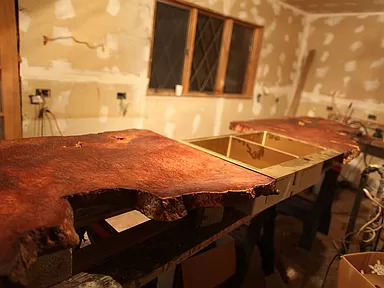
This is going to be the kitchen.
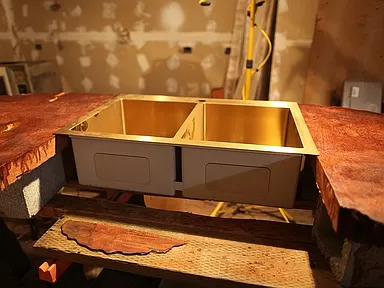
The gold double sink.

I don't know if this is an old picture of the original inspiration for this home, but it's definitely a representation of the home itself.

This is an amazing fireplace.

Another beautiful fireplace.

He's using the bedroom, but it's not finished.
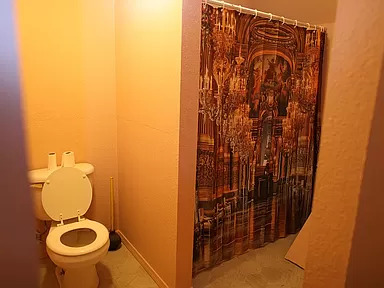
I'm disappointed in this bathroom. Maybe it's just temporary?

He has a lot of photos of the furniture and these are really primo antiques. So, this would be one of the dining rooms.

This looks like a brand new bedroom set. Looks like a furniture store that used to be near me called Roma Furniture.

The chandelier in the ballroom that he says is included in the sale.

One of the sitting rooms.

Nice inlaid table.
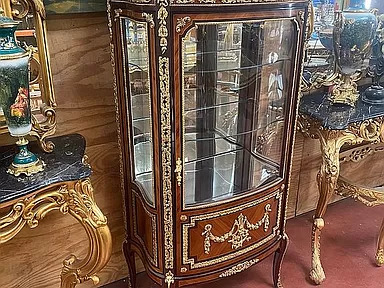
There's a lot of furniture. If you want to see it all, click on the link b/c he's posted 100 photos. But, I'm very confused.



The property measures 6 acres and there are "massive fall color and rose gardens, 20,000 plantings, plus 10,000 daffodil, iris, lily, etc. Bulbs are spread over 6 acres, still there mostly, alive and colorful. Plus, hundreds of valuable landscaping sculptures are included."
122 notes
·
View notes
Text
August 1 - Kaohsiung - Lotus Pond, Qishan Train Station Museum
This morning, our first stop was the Lotus Pond and the temples over the water. First, we stopped at the Dragon and Tiger Pagodas. Unfortunately, it was under construction, and there were scaffoldings all around it, so we couldn't fully grasp its beauty. However, we could still go into the Dragon and the Tiger. As in any temple, you have to enter into the dragon side and leave through the Tiger side, as we saw already in the temple in Taipei. Inside showed Confucius' Twenty-four Filial Exemplars on the left and hell on the right side (see images below). The mural was fascinating and beautifully made. The giant dragon and tiger were super cool to walk into and experience that temple. Next, we went to the Spring and Autumn Pavilions. Right in the center, there was a much longer dragon that you could walk inside of. Conversely, people were praying at shrines built inside of this dragon. Around the dragon were two pavilions and a long walkway down to the final pavilion with a second story. We walked out over there and enjoyed the view from the center of the Lotus Pond.
Afterward, we got treated to an all-you-can-eat Mongolian BBQ lunch. It was delicious, and I stuffed myself with as much as possible. Finally, we went to the Qishan Train Station, but there wasn't much there, so we didn't stay for long. The old train cars were interesting to see. As I write this, it is 5:00 pm, and there is still time in the day, but our class activities are over. I plan to go to the Rui Feng Night Market for dinner, so I will upload another post with what I eat after this one!
Academic Reflection
On the bus going towards the Lotus Pond and inside the dragon at the Dragon and Tiger Pagodas, our tour guide Peter had taught me about Confucius' Twenty-four Filial Exemplars. These stories were a Confucious text written in the Yuan dynasty as an example of respecting one's parents and elders. Each of the 24 stories inside the dragon was depicted on a mural. Knowing a few from Peter and then reading about them afterward has allowed me to appreciate it much more. Here are some examples of the stores: One son was in a poor family that did not have mosquito nets, so instead of letting his parents get bit, he allowed the mosquitoes to drain him until they were full. One son sold himself into servitude to pay for his father's funeral expenses. Emperor Wen of the Han Dynasty tasted his mother's medicine to ensure it was safe and effective. These are just three of the twenty-four stories in this Pagoda mural (Jordan 1-8).
Overall, learning these stories depicts the culture of respecting your elders, which is prevalent here, in China, and anywhere in which Confucius' lessons are heavily followed. Although in the US, we, too, mostly respect our elders, it is nothing compared to how much they do here and how it is depicted in this lesson. This is one culture that is important and is something that we should pick up in the US.
Jordan, David K. The Twenty-four Filial Exemplars. University of California, San Diego, https://pages.ucsd.edu/~dkjordan/chin/shiaw/FilialExemplarsEnglish.pdf. Accessed 31 July 2024.










2 notes
·
View notes
Text
The messages are scrawled on the toilet walls and across stall doors, on the tiles and next to the holders for paper. In Chinese characters, with the occasional English phrase, they echo the words of the protest banner that was unfurled across a busy overpass in Beijing: “No to confinement, we want freedom! No to lies, we want dignity! No to the great leader, we want to vote!”
The stunning act of defiance at the bridge took place on the eve of the 20th Communist party congress, when Xi Jinping officially embarked on a custom-breaking third term as China’s supreme leader, surrounded by a politburo stacked with his loyalists. The party’s narrative of confidence and triumph was nevertheless punctured by one man’s disobedience.
Like the rumblings of thunder that follow a flash of lightning, the daring proclamation has reverberated across the country, despite the bridge protester’s forced disappearance. Public restrooms, one of the last physical spaces in China beyond the government’s watch, have emerged as an unexpected venue for dissent. Replicas of the original banner have been spotted in London across Westminster Bridge and outside the Chinese embassy. Overseas Chinese students have also put up posters in solidarity on telephone poles and university noticeboards.
I click through the images from campuses across North America and Europe. I try to picture the anonymous young faces behind the handwritten notes and hastily designed placards, and catch glimpses of myself from a decade ago. I was one of these students, making sense of a new country while for ever tied to the old home, sizing up newly gained freedoms and wondering how to best exercise them.
When I left China for graduate school in the US in 2009, it still seemed possible to navigate the world with a map of conventional wisdom. My birth country has now become so unrecognisable that I sometimes wonder if the past was a figment of my imagination. With the benefit of hindsight, one can clearly see the trajectory of Beijing’s authoritarian ascent, as the tightening of control began before Xi’s reign. Now, the speculation about how long the red emperor might rule carries the same whiff of denial as the old talk of “Xi the reformer” when he first took office, and the recurring fantasies of a palace coup. The obsession with an individual tyrant overlooks the system that enables that tyranny.
In Xi’s latest address at the party congress, there was no mention of “political reform” or “intra-party democracy”, key phrases that had appeared in all previous reports since the early 1980s. The significance of this shift is not so much that the party has changed, but that it no longer needs the pretence – just like the all-male, 24-member politburo that was unveiled last week, breaking another decades-old convention where one or two women held token seats (though never on the standing committee).
From the very beginning, gestures to “democracy” and “reform” were in service to the Chinese leadership. After the disasters of the Mao era, the party needed new legal and institutional scaffolding to reclaim legitimacy, and to facilitate the transition from a planned economy to integration with the capitalist market. Before Xi consolidated power, competing factions at the top and opaqueness within the bureaucracy meant there was limited flexibility to question and experiment. Individuals and civil society groups manoeuvred this fragile space in order to push for social progress.
Yet the party has never relented on the issues that are central to its power, or hesitated to use force against perceived challenges. A periodic loosening of controls is wielded as an effective tool to gather information and maintain control. With the end of performative deference to legal rules and institutional norms, a party that governs by fear and patronage will embolden the worst instincts of the bureaucracy, where loyalty is rewarded over competence, power is rarely held accountable, and mistakes in policy become exceedingly difficult to correct.
The future is grim, not just for China and its people. Many in the west who have been drumming up a “new cold war” with China take every instance of Beijing’s abuses as proof of a “China threat” and justification for expanding the national security state. The new cold warriors are not so different from their counterparts a generation ago, who preached that marketisation and free trade would usher in political liberalisation. Both narratives stem from an unabashed belief in the supremacy of their own system: the “end of history”. Shifting blame to a faceless foreign other is a convenient diversion from raging crises at home.
The primary struggle in the world today is not the essentialist framing of China versus the US, east versus west. Nor is it the reductionist idea of democracy versus autocracy, freedom versus captivity. The rights and liberties taken for granted in the ostensibly democratic west have been subsidised by cheap labour and imports from authoritarian countries. The free flow of capital demands that toiling bodies be kept in place.
The fundamental choice is between clinging to an old order crumbling under its own weight, and forging a new world while there’s still time. We’re all exiles from a past we thought we knew, stranded on an ice cap amid warming seas. We can fight each other for the receding higher ground, or build lifeboats together: alternative futures of mutual care in which value is not conditional on exclusion or domination.
I cannot recall when I entered a state of perpetual mourning. I grieve for the country I left with no certain prospect of return, the direction it’s heading in, the plight of the world, the foreclosed possibilities. Sorrow tears into my organs and gnaws at my bones. But what I fear more than pain is numbness: to give in to the powers that be, and give up on imagining otherwise.
I remind myself that for a Chinese woman, learning how to read and moving to a foreign country were once revolutionary acts conceived in fugitive spaces. No control is absolute. Power at its most menacing and totalising is also insecure and unsustainable. I hold no illusions about the long night ahead, but each refusal of injustice preserves an opening. Every act of rebellion, however spectacular or humble, is a reclamation of the self and a love letter to a stranger. Across the darkness, another searching gaze catches the flicker, and a sacred bond is cast: I see you. I feel you. We are still here.
6 notes
·
View notes
Text
How Is The Anti-Aging Effect Of 6.78mhz Monopolar RF Thermage?
Article source: https://www.litonlaser.com/how-is-the-anti-aging-effect-of-6-78mhz-monopolar-rf-thermage/
We all know that the maximum temperature that the human epidermis can withstand is 42-43℃. To stimulate the collagen regeneration in the dermis, the deep temperature needs to reach 55-65℃.
Under this condition, our skin can start the regeneration mechanism. Under the action of continuous collagen, the originally sagging wrinkles are tightened and the aged skin is regenerated. This is the process of anti-aging and wrinkle removal.
In today’s medical beauty market, there are many types of anti-aging projects, among which RF radio frequency is very prominent. It is safe and effective and recognized by many beauty industry people. Among them, monopolar RF beauty machines have been widely promoted. 6.78MHz monopolar RF anti-aging and wrinkle removal beauty equipment occupies half of the anti-aging projects!

1. What is Thermage?
Thermage, also known as Thermage, was invented by Dr. Edward W. Knowlton of the United States in 1995 and has now developed to the fifth generation. The treatment equipment, which has obtained three certifications from the US FDA, the EU CE and the China CFDA, ensures safety for the human body. It is also a globally recognized medical beauty device that can achieve significant lifting, firming and wrinkle removal effects through one treatment.
Thermage is a radio frequency device. The heat energy of 45-75° is generated by the resonance of water molecules, just like a microwave oven.
Although the energy is sufficient, the penetration depth is not strong, and it can only reach the dermis at most.
Thermage focuses on firming and is suitable for people whose face is sagging and their skin is beginning to sag. It is also effective for tear grooves, nasolabial folds, and large pores.
2. Principle of monopolar RF anti-aging treatment.
Thermage is a monopolar radio frequency. Radio frequency is an electromagnetic wave that can be emitted into the air. Electromagnetic waves have energy. When acting on the skin or body tissues, there will be an equivalent current, which will produce an ohmic heat effect, thereby generating heat, which can raise the temperature in the dermis of the skin to 60-70 degrees, stimulate the regeneration of collagen and elastic fibers, and rearrange the collagen scaffold to make the skin firm and elastic.
The penetration depth of monopolar radio frequency is deeper than that of bipolar radio frequency, and the range of skin tissue heating is deeper and wider, which can reach the deep dermis of the skin. It is volume heating, with obvious immediate contraction effect and long-term regeneration effect. Moreover, 6.78Mhz penetrates deeper than 3-4Mhz, has more concentrated energy than 40.68Mhz, and can generate heat better in the deep dermis.
Thermage belongs to radio frequency technology, which is a 6.78Mhz (megahertz) monopolar high-frequency electromagnetic wave that can be transmitted to the deep dermis of the skin. The target tissue of radio frequency is the water in the dermis-subcutaneous fat. It heats the water and collagen, which has an immediate contraction reaction, causing an immediate skin firming effect, and achieving the purpose of lifting and anti-wrinkle.
Although Thermage has no direct effect on melanin, the thermal effect of Thermage can accelerate the division of dermal cells, promote cell activity, increase cell membrane permeability, promote blood and lymphatic circulation, accelerate metabolism, anti-inflammatory, and assist in repairing the skin barrier; therefore, Thermage has an auxiliary therapeutic effect on chloasma, and patients with chloasma can do Thermage.
However, during the operation, the energy should be appropriately reduced for the chloasma area to avoid blisters caused by burns and irritation of chloasma. In addition, for vascular and vascular dominant chloasma, it is best not to apply anesthetics if the capillaries are significantly dilated and the barrier is significantly damaged. At this stage, people with chloasma are prone to adverse reactions such as anesthetic allergies and anesthetic burns, which cause inflammatory reactions in the skin and easily lead to the darkening of chloasma.

3. Scope of application of monopolar RF machine.
3.1 Facial anti-aging and wrinkle removal:
Deep wrinkles, folds, forehead wrinkles, nasolabial fold lifting, lip wrinkles, brow wrinkles, etc.
3.2 Neck wrinkle removal:
Tighten neck skin, eliminate double chin, and slim face
3.3 Eye wrinkle removal:
Wrinkles around the eyes, crow’s feet, eye bags, tighten loose skin around the eyes
3.4 Whole body anti-aging:
Back tightening and shaping, chest adjustment, waist and abdomen shaping, buttocks shaping, leg shaping, butterfly sleeve removal, repair of mild stretch marks
4. Who should not do Thermage project?
Pregnant women are not allowed to do this project.
Epilepsy patients.
Avoid using in tumor areas.
Customers with pacemakers or life-supporting electronic devices implanted in their bodies.
Those with metal implants in the affected area.
Those with heart failure and high blood pressure.
Those with excessive sunburn.
New scars or wounds, local or systemic infections. Acne, keratosis, seborrheic warts; thrombophlebitis, diabetes, epiphysis.
Long-term use of immunosuppressants and anticoagulants, users of retinoic acid.
5. Precautions after treatment with a monopolar RF machine.
It is normal to have temporary redness and swelling after treatment. Be careful not to go to a high temperature environment within one week after surgery, and it is best not to be exposed to the sun.
Keep the skin and hair clean and hygienic before surgery. Do not wear makeup on the day of surgery, and try to remove any traces of previous makeup.
Do not wash your face with hot water within three days (water that does not exceed body temperature is fine); pay attention to hydration. It is recommended to apply a medical mask at least 3 times a week.
Avoid washing your face with hot water within one week after treatment, avoid hot springs, saunas, etc., and strengthen moisturizing and sun protection when going out.
Do not drink alcohol or eat spicy food.
6. Other types of anti-aging machines.
6.1 Ultrasonic anti-aging equipment.
Ultrasonic knife (HIFU), 7D polylift, and ultrasonic gun are all ultrasonic anti-aging devices. Their working principle is to use ultrasonic transducers to focus ultrasonic waves within a specific frequency range to a focal point at a specific distance. The energy density of the focused ultrasonic waves is increased, and the focal point acts on the dermis of the facial skin. Ultrasound vibrates and heats the skin moisture, making the collagen in the deep dermis reach a focal point temperature of 60-70℃, and the protein coagulates and denatures. Then the skin self-repair mechanism is activated to stimulate the regeneration of collagen fibers, achieving the effect of lifting, firming, and facial fat reduction. Among them, the gun head of the ultrasonic gun adopts a unique ultrasonic large focal area focusing technology, which can effectively reduce the ultrasonic energy density in the treatment area, and the energy acting on the skin tissue is more uniform and gentle.

In addition to the anti-aging effect, ultrasound has a “heat-vibration” effect, which can promote blood circulation, accelerate the growth of fibroblasts and promote the production of collagen. Therefore, ultrasound has anti-inflammatory and repair effects, and also has a certain whitening effect. Therefore, patients with chloasma can also do ultrasonic anti-aging projects. However, when using the ultrasonic knife, 7D polylift, and ultrasonic gun heads for patients with chloasma, try not to use the zygomatic bone, or reduce the energy, reduce the number of repeated superpositions, and reduce heat accumulation to avoid irritation. For vascular and vascular dominant chloasma, when the capillaries are obviously dilated and the inflammatory reaction is severe, it is recommended to first repair the barrier and fight inflammation, and then use ultrasonic anti-aging after the skin barrier is stable. If the customer insists on doing it, you can use a 1.5mm or 2.0mm deep treatment head with low energy. If it is an ultrasonic gun, it is recommended to use the gun head, which is safer.
6.2 Fractional beauty machines
The wavelength of CO2 fractional laser is 10600nm, with a high water absorption coefficient of about 780, and has a strong epidermal exfoliation and superficial dermal destruction effect. After CO2 fractional laser treatment, tiny holes will appear in the epidermis, and a “coin-shaped” skin reaction will appear. The central tissue of the laser irradiation point will be completely vaporized and exfoliated, and the surrounding tissue will have a white frost reaction due to water vaporization. The outermost tissue will have protein denaturation. The penetration and destruction depth of a single treatment is usually 80-150μm, causing columnar thermal damage/coagulation in the superficial dermis.
CO2 fractional laser is suitable for micro-exfoliation-exfoliation treatment, which can treat hyperplastic or depressed scars, laser skin resurfacing, and strong anti-aging and treatment of true wrinkles.
1927nm thulium laser is a long-pulse infrared laser. The main target tissue absorbed by the skin is water, with an absorption rate of 130. Since the moisture content of the dermis is higher than that of the epidermis, most of the energy of the thulium laser passes through the epidermis during skin treatment. The energy is mainly absorbed by the dermis and heated up. The epidermis forms an almost “translucent window” during the thulium laser transmission. Its penetration depth is about 200-400μm. If the energy is high, the epidermis will also produce slight thermal damage vaporization and slight scabs.
Thulium laser treatment belongs to the category of non-ablative-micro-ablative. Due to the deep penetration depth and obvious thermal diffusion effect of the skin, thulium laser is very safe and not easy to burn the skin. In normal treatment, there is no downtime and obvious skin damage. Therefore, it can safely heat the deep dermis to stimulate collagen regeneration and achieve anti-aging and wrinkle removal functions.
7. How to choose a reliable monopolar RF machine?
As the safest photoelectric beauty machine series in the anti-aging project, the monopolar RF beauty machine is the first choice of many people, not only because of the good anti-aging effect, but also because of its high safety. There is no need to worry about accidental damage to the facial nerves during the facial anti-aging process (such as HIFU).
For monopolar RF machines, we also need to consider two basic aspects.
7.1 Selection of RF frequency.
Compared with other frequencies, the 6.78MHz monopolar radio frequency is recognized as the best anti-aging frequency! The original American Thermage uses this frequency. Litonlaser’s Beauty Technology Training Center also analyzed and experimented on this band to prove its correctness.
7.2 Monopolar RF or bipolar RF?
Thermage uses monopolar RF, including many excellent manufacturers, such as LITONLASER’s RF machine, which is also monopolar-based.
Why choose monopolar RF? This is because when a monopolar RF machine is used for treatment, the client is usually asked to attach a negative plate on the back, so that the current of the monopolar machine will spread from the client’s face to the negative plate on the back, forming a closed circuit, which allows the microcurrent to spread throughout the body and reach the deeper skin, thus achieving the best anti-aging effect.
Bipolar RF beauty machines are usually installed on portable or home RF machines, and this effect will be greatly reduced because it will directly pass through the surface layer and leave, lacking the stimulation and regeneration of collagen in the dermis.
If you need more anti-aging videos and information about monopolar RF machines, you can contact us at any time through the website.
We not only provide beauty machines, but also have a professional training center for technical support, as well as perfect after-sales service, providing high-quality services.
0 notes
Text
How Are Recent Innovations Shaping the Future of the Neurovascular Device Market?

Introduction:
The Neurovascular Device Market is undergoing a significant transformation driven by a series of recent innovations and breakthroughs. As the field of neurovascular intervention continues to evolve, these developments are poised to enhance patient outcomes and redefine treatment standards. This article explores how the latest advancements are shaping the future of the neurovascular device market, providing insights into the cutting-edge technologies and trends influencing the industry.
Download FREE Sample: https://www.nextmsc.com/neurovascular-device-market/request-sample
1. What Are the Latest Innovations in Neurovascular Devices?
Recent innovations in neurovascular devices are pushing the boundaries of what is possible in the treatment of cerebrovascular conditions. Key advancements include:
1.1. Advanced Stent Technologies
The development of next-generation neurovascular stents represents a significant leap forward. Companies like Medtronic and Stryker have introduced stents with improved delivery systems and enhanced biocompatibility. For instance, the Medtronic Solitaire X stent retriever has been designed to offer superior clot removal capabilities with a more precise deployment mechanism, leading to better clinical outcomes in thrombectomy procedures.
1.2. Bioresorbable Devices
Bioresorbable devices are gaining traction as a promising innovation. Unlike traditional metal stents, bioresorbable stents gradually dissolve over time, leaving behind a restored blood vessel without a permanent implant. Abbott’s Absorb BVS, though discontinued, has set a precedent for future developments in this area, highlighting the potential for bioresorbable materials to improve long-term patient outcomes.
1.3. Next-Generation Coiling Systems
Advancements in endovascular coiling systems are improving the treatment of cerebral aneurysms. Newer coiling systems, such as those developed by Penumbra, offer enhanced stability and control during deployment, which helps in better aneurysm occlusion and reduces the risk of recanalization.
2. How Are Regulatory Approvals Impacting the Market?
Regulatory approvals are crucial in determining the success of new neurovascular devices. Recent approvals and clearances have had a significant impact on the market, facilitating the introduction of innovative products.
2.1. FDA Approvals
The U.S. Food and Drug Administration (FDA) has recently approved several new neurovascular devices, including:
Cerenovus’ PulseRider: A novel device designed to treat complex intracranial aneurysms by providing a scaffold for coiling. Its approval marks a significant advancement in the management of challenging aneurysm cases.
Inari Medical’s ClotTriever: This device, designed for mechanical thrombectomy, has received FDA clearance for its effectiveness in removing large clots from deep veins, demonstrating its potential for broader applications beyond stroke treatment.
2.2. European CE Markings
In Europe, the CE Marking has been granted to several new neurovascular devices, including the Stryker Surpass Streamline stent. This approval allows for the commercialization of these devices across European markets and contributes to the global expansion of neurovascular treatment options.
3. What Role Do Emerging Markets Play in the Neurovascular Device Industry?
Emerging markets are becoming increasingly important in the neurovascular device industry. The growing healthcare infrastructure and rising prevalence of neurovascular disorders in these regions are driving market expansion.
3.1. Market Growth in Asia-Pacific
Countries in the Asia-Pacific region, such as China and India, are experiencing rapid growth in healthcare spending and infrastructure development. This growth is facilitating the adoption of advanced neurovascular devices. For example, the introduction of minimally invasive neurovascular technologies in these markets is improving treatment accessibility and driving market demand.
3.2. Expansion in Latin America and the Middle East
Similarly, Latin America and the Middle East are witnessing increased investment in healthcare infrastructure and a growing focus on advanced medical technologies. The rise in neurovascular conditions in these regions is prompting healthcare providers to seek innovative solutions, boosting the market for neurovascular devices.
4. How Is the Focus on Minimally Invasive Procedures Affecting Device Development?
The shift towards minimally invasive procedures is a major trend influencing the neurovascular device market. This focus is driving the development of new devices and techniques aimed at reducing patient recovery times and improving procedural outcomes.
4.1. Enhanced Catheter Technologies
Recent advancements in catheter technologies are enabling more precise and controlled interventions. Innovations such as the Penumbra 3D Revascularization Device are designed to enhance clot retrieval and reduce procedure-related complications.
4.2. New Imaging Techniques
The integration of advanced imaging techniques, such as 3D rotational angiography and intravascular ultrasound, is improving the accuracy of neurovascular interventions. These techniques provide detailed visualization of blood vessels, allowing for better planning and execution of procedures.
5. What Impact Do Strategic Collaborations Have on the Market?
Strategic collaborations between medical device companies, research institutions, and healthcare providers are playing a crucial role in advancing neurovascular device technology.
5.1. Industry Partnerships
Partnerships between companies like Medtronic and Boston Scientific are driving innovation through joint R&D efforts. These collaborations enable the sharing of expertise and resources, leading to the development of cutting-edge neurovascular devices and technologies.
5.2. Academic and Research Collaborations
Collaborations with academic institutions and research organizations are also contributing to the advancement of neurovascular devices. For instance, partnerships with institutions such as the Cleveland Clinic are facilitating clinical trials and research studies that support the development and validation of new devices.
6. How Are Patient-Centered Approaches Influencing Device Design?
Patient-centered approaches are increasingly influencing the design and development of neurovascular devices. The focus is shifting towards creating devices that not only improve clinical outcomes but also enhance the overall patient experience.
6.1. User-Friendly Designs
Design improvements aimed at enhancing ease of use and patient comfort are becoming more common. For example, new devices are being designed with features that simplify deployment and reduce procedural complexity, benefiting both patients and healthcare providers.
6.2. Personalized Treatment Options
Advancements in personalized medicine are influencing the development of customized neurovascular devices. Personalized treatment approaches are being integrated into device design to cater to the specific needs of individual patients, improving treatment efficacy and safety.
Conclusion
The neurovascular device market is rapidly evolving, driven by recent innovations, regulatory approvals, and emerging market opportunities. Advances in device technology, a focus on minimally invasive procedures, and strategic collaborations are shaping the future of neurovascular interventions. As the industry continues to grow and innovate, these developments are expected to enhance patient outcomes and redefine treatment standards in neurovascular care.
For stakeholders in the neurovascular device industry, staying abreast of these trends and innovations is crucial for navigating the competitive landscape and capitalizing on emerging opportunities.
0 notes
Text
Artificial Blood Vessels Market: CAGR of 6.04% by 2032
As per Inkwood Research, the Global Artificial Blood Vessels Market is expected to grow at a CAGR of 6.04% in terms of revenue over the forecasting period of 2024-2032.

Artificial blood vessels are engineered substitutes designed to replace damaged or diseased vessels. They offer a solution for patients requiring vascular repair or replacement, potentially improving outcomes in procedures like bypass surgeries. Advances in materials and manufacturing techniques continue to enhance the performance and longevity of these vital medical devices.
REQUEST FREE SAMPLE : https://inkwoodresearch.com/reports/global-artificial-blood-vessels-market/#request-free-sample
Tissue Engineering Advances to Boost Artificial Blood Vessels Market Growth
Advances in tissue engineering are significantly boosting the artificial blood vessels market by enhancing the design and functionality of these critical medical devices. Innovations in biomaterials, 3D printing, and cellular therapies are improving the durability, biocompatibility, and performance of artificial blood vessels. Researchers are developing more sophisticated scaffolding techniques and incorporating stem cell technology to create vessels that better mimic natural tissues. These advancements are addressing key challenges such as graft failure and limited availability, thereby driving market growth. As technology progresses, the artificial blood vessels market is expected to expand, offering improved solutions for vascular repair and replacement.
Large is Expected to be Prominent Blood Vessel Diameter
Large artificial blood vessel grafts, with diameters ranging from 6 mm to over 30 mm, are designed to replace or bypass major vessels like the aorta, iliac arteries, or femoral arteries. Engineered to withstand the high pressures and flow rates of the cardiovascular system, these grafts are essential in procedures such as aortic aneurysm repair, where a synthetic graft replaces a section of the aorta. Choosing the right graft material and design involves considering factors such as the vessel’s location and diameter, expected blood flow rates and pressures, and individual patient characteristics to ensure optimal performance and compatibility.
Asia-Pacific is Projected to be the Leading Region over the Forecasted Years
The Asia-Pacific has experienced significant growth in the global artificial blood vessels market, primarily due to the rising prevalence of cardiovascular diseases. The demand for vascular grafts and related procedures has surged, driven by the region's aging populations, particularly in countries like Japan and China, where elderly individuals often require vascular interventions.
The global artificial blood vessels market is highly competitive, with numerous companies vying for market share through innovation and advanced technology. Key players differentiate themselves by developing superior materials and improving graft performance to address various clinical needs and preferences. Some of the leading companies operating in the market include B Braun Melsungen AG, Becton Dickinson and Company, LeMaitre Vascular Inc, Medtronic plc, etc.
Request for Customization : https://inkwoodresearch.com/request-for-custom-report/
Related Reports:
CHROMATOGRAPHY RESIN MARKET : https://www.inkwoodresearch.com/reports/chromatography-resin-market/
SINGLE-USE BIOPROCESSING MARKET : https://www.inkwoodresearch.com/reports/single-use-bioprocessing-market/
BONE GRAFT AND SUBSTITUTE MARKET : https://www.inkwoodresearch.com/reports/bone-graft-and-substitutes-market/
About Inkwood Research
Inkwood Research specializes in syndicated & customized research reports and consulting services. Market intelligence studies with relevant fact-based research are customized across industry verticals such as technology, automotive, chemicals, materials, healthcare, and energy, with an objective comprehension that acknowledges the business environments. Our geographical analysis comprises North & South America, CEE, CIS, the Middle East, Europe, Asia, and Africa.
Contact Us
1-(857)293-0150
0 notes
Text
Medical Inorganic Non-metallic Materials, The Top 16 Largest Companies in China Ranked by Revenue in 2023 (2023)
Medical Inorganic Non-metallic Materials Market Summary
Inorganic non-metallic biomaterials mainly include bioceramics, bioglass, oxides and calcium phosphate ceramics and medical carbon materials. Bioceramics have excellent properties such as high hardness, high strength, low density, high temperature resistance and corrosion resistance, and are widely used in the fields of medical bone substitutes, implants, dentistry and orthopedic prostheses.
3D printed ceramic implants include silicon nitride, aluminum oxide, hydroxyapatite and other types. Among them, ceramic materials such as hydroxyapatite have good biocompatibility and will be gradually degraded and absorbed by the human body after implantation. Scientists in the fields of bioengineering and regenerative medicine have developed ceramic bioscaffolds for repairing bone defects using the characteristics of such ceramic materials.
Bioglass is an aggregate of silicates with randomly arranged internal molecules. It mainly contains several metal ions such as sodium, calcium and phosphorus. Under certain ratios and chemical reaction conditions, it will generate a complex containing calcium hydroxyphosphate, which has high biomimetic properties and is the main inorganic component of biological bone tissue. Since bioglass materials are degradable and bioactive and can induce the regeneration of bone tissue, they are widely used as tissue engineering scaffold materials in the research field of bone tissue engineering and have very broad application prospects in the field of inorganic non-metallic materials.
According to the new market research report "China Medical Inorganic Non-metallic Materials Market Report 2024-2030", published by QYResearch, the global Medical Inorganic Non-metallic Materials market size is projected to reach USD 264 million by 2030, at a CAGR of 6.52% during the forecast period.
Figure. China Medical Inorganic Non-metallic Materials Market Size (US$ Million), 2019-2030

Figure. China Medical Inorganic Non-metallic Materials Top 16 Players Ranking and Market Share (Ranking is based on the revenue of 2023, continually updated)

According to QYResearch Top Players Research Center, the china key manufacturers of Medical Inorganic Non-metallic Materials include Shandong Sinocera Functional Materials, Kyocera, Ivoclar Vivadent, Jiangxi Size Materials, Orbray, Tosoh Corporation, Dentsply Sirona, DSM, DePuy Synthes, NovaBone, etc. In 2023, the china top 10 players had a share approximately 75.0% in terms of revenue.
Figure. Medical Inorganic Non-metallic Materials, China Market Size, Split by Product Segment

In terms of product type, currently Zirconia is the largest segment, hold a share of 55.5%. Due to the strong stability and strong antioxidant ability of zirconium oxide, it has been increasingly used in the production of dentures and clinical treatment.
Figure. Medical Inorganic Non-metallic Materials, ChinaMarket Size, Split by Application Segment

In terms of product application, currently Orthopedics is the largest segment, hold a share of 42.2%. Bioactive glass and bioceramics can be used as filling materials to repair carious or worn teeth. It can bond well with tooth tissue and has antibacterial and caries-inhibiting properties. In endodontic treatment, bioactive glass can be used as a filling material. It has good compatibility with pulp tissue and helps regenerate and repair pulp tissue. In the field of dentistry, bioactive glass has good biocompatibility and bioactivity, which can promote the repair and regeneration of tooth tissue.
Market Drivers:
Growth in medical demand: As China's population ages, the demand for medical and health services continues to rise, especially for medical materials such as orthopedic implants, dental restorations, and cardiovascular stents. In addition, as people's living standards improve, the demand for medical quality is also growing, which has promoted the technological innovation and application expansion of medical materials.
Policy support: The government's emphasis on the medical and health field and policy support for the research and development of new materials have provided a good development environment for the medical inorganic non-metallic materials industry. Clear regulations, standards, and approval processes have accelerated the transformation of new materials from laboratory to clinical application.
Opportunity:
Improved biocompatibility and functionality: The research and development focus is to improve the compatibility of materials with human tissues, reduce rejection reactions, and enhance their specific functionality, such as antibacterial properties, osteoconductivity, or drug sustained release.
Regenerative medicine and tissue engineering: In the field of tissue engineering, inorganic non-metallic materials are used as scaffold materials to promote cell growth and tissue regeneration. For example, bioglass and bioceramics are used to guide the regeneration of bones and soft tissues, and future research in this field will further promote clinical applications.
Development of composite materials: By combining inorganic non-metallic materials with different properties with other materials (such as polymers and metals), new medical materials with better comprehensive performance can be obtained.
About The Authors
Jiashi Dong
Lead Author
Email: [email protected]
QYResearch Nanning Branch Analyst, as a member of the QYResearch Semiconductor Equipment and Materials Department, his main research areas include automotive electronics, semiconductor equipment, materials and thermally conductive powders. Some subdivided research topics include automotive diodes, automotive inductors, automotive lidar, radio frequency power supplies, plastic sealing machines, high-purity non-ferrous metals, battery materials, precursors, electroplating equipment, thermal conductive ball aluminum, semiconductor chemical plating solutions, semiconductor coating devices, etc. At the same time, he is also engaged in the development of market segment reports and participates in the writing of customized projects.
About QYResearch
QYResearch founded in California, USA in 2007.It is a leading global market research and consulting company. With over 17 years’ experience and professional research team in various cities over the world QY Research focuses on management consulting, database and seminar services, IPO consulting, industry chain research and customized research to help our clients in providing non-linear revenue model and make them successful. We are globally recognized for our expansive portfolio of services, good corporate citizenship, and our strong commitment to sustainability. Up to now, we have cooperated with more than 60,000 clients across five continents. Let’s work closely with you and build a bold and better future.
QYResearch is a world-renowned large-scale consulting company. The industry covers various high-tech industry chain market segments, spanning the semiconductor industry chain (semiconductor equipment and parts, semiconductor materials, ICs, Foundry, packaging and testing, discrete devices, sensors, optoelectronic devices), photovoltaic industry chain (equipment, cells, modules, auxiliary material brackets, inverters, power station terminals), new energy automobile industry chain (batteries and materials, auto parts, batteries, motors, electronic control, automotive semiconductors, etc.), communication industry chain (communication system equipment, terminal equipment, electronic components, RF front-end, optical modules, 4G/5G/6G, broadband, IoT, digital economy, AI), advanced materials industry Chain (metal materials, polymer materials, ceramic materials, nano materials, etc.), machinery manufacturing industry chain (CNC machine tools, construction machinery, electrical machinery, 3C automation, industrial robots, lasers, industrial control, drones), food, beverages and pharmaceuticals, medical equipment, agriculture, etc.
0 notes
Text
Construction Scaffolding Market Share, Challenges, Trend, Segmentation and Forecast 2031
The Insight Partners latest offering, titled “Construction Scaffolding Market Size and Share Analysis to 2031,” provides comprehensive insights for startups and big market players. The report covers industry performance, risk factors, growth determinants, economics of cost, and ROI streams. It combines qualitative and primary research methods, making it an essential product for companies, investors, and business strategists aiming to excel in the Construction Scaffolding market in a projected timeframe.

Market Overview
Construction Scaffolding market has experienced dynamic transformations in recent years, anticipated to remain an investible domain for investors in the projected time. The market is propelled by consumer preferences, regulatory parameters, and advancements in technology. Concurrently, the surge in automation has favored Construction Scaffolding market share expansion. Advancements in manufacturing technologies have made the Construction Scaffolding market viable and accessible, which is further expected to contribute to market growth.
In confluence with the aforementioned growth drivers, the Construction Scaffolding market is also gauged for restraints and trends. The emerging trends in the market are analyzed in this chapter to assist market players in trying to retain their competitive edge. Strategic insights on key players and their tactics are perks of this research. This section brings forward different organic business strategies, strategic partnerships, and collaborations in the Construction Scaffolding market.
Market Segmentation
To adequately aid their customers in a competitive Construction Scaffolding market, enterprises must educate themselves on key segments. Streamlining market approaches is an effective application of market research. The market segmentation section focuses on product, application, and regional categories. Understanding demographics and high-ROI geographical regions helps entrepreneurs optimize their products.
Regional Insights
The report attempts to explore both global and regional market aspects through authorized sources. Regional share, trends, key market players, and future scope are perks under this section.
Report Attributes
Details
Segmental Coverage
By Offering
Scaffolding Products (Sale) and Rental Solutions
Type
Frame Scaffolding
Tube and Clamp Scaffolding
Ringlock Scaffolding
Cuplock Scaffolding
End User
Residential Building
Commercial Building
Industrial
Oil and Gas Industry
Events
Geography
North America
Europe
Asia Pacific
and South and Central America
Regional and Country Coverage
North America (US, Canada, Mexico)
Europe (UK, Germany, France, Russia, Italy, Rest of Europe)
Asia Pacific (China, India, Japan, Australia, Rest of APAC)
South / South & Central America (Brazil, Argentina, Rest of South/South & Central America)
Middle East & Africa (South Africa, Saudi Arabia, UAE, Rest of MEA)
Market Leaders and Key Company Profiles
Pilosio SRL
Wilhelm Layher GmbH & Co KG
Altrad Plettac Assco GmbH
Atlantic Pacific Equipment LLC
Caspian Group Ltd
PSB Scaffolding Group Ltd Rotamead Ltd
Catari Industria SA
Ozler Kalip Ve Iskele Sistemleri AS
Yagmur Iskele Sistemleri AS
Other key companies
Need a Customized Market Research Report?
You can always share any specific requirements that you have, and our team will adjust the scope of research offerings as per your needs. the following are some customizations our clients ask for:
The report can be customized based on specific regions/countries as per the intention of the business
The report production was facilitated as per the need and following the expected time frame
Insights and chapters tailored as per your requirements.
Depending on the preferences we may also accommodate changes in the current scope.
Key Questions Addressed in the Construction Scaffolding Market Research Include:
What are present Construction Scaffolding market values, and what can be expected in the upcoming decade?
What are the key segments in the Construction Scaffolding market?
What is the regional distribution of the Construction Scaffolding market report?
What are the key players and their recent strategies?
What are the key factors driving Construction Scaffolding market growth?
What are regulatory concerns and requirements businesses have to compel?
Our Unique Research Methods at The Insight Partners
We offer syndicated market research solutions and consultation services that provide complete coverage of global markets. This report includes a snapshot of global and regional insights. We pay attention to business growth and partner preferences, that why we offer customization on all our reports to meet individual scope and regional requirements.
Our team of researchers utilizes exhaustive primary research and secondary methods to gather precise and reliable information. Our analysts cross-verify facts to ensure validity. We are committed to offering actionable insights based on our vast research databases.About Us:
The Insight Partners is a one-stop industry research provider of actionable intelligence. We help our clients in getting solutions to their research requirements through our syndicated and consulting research services. We specialize in industries such as Semiconductor and Electronics, Aerospace and Defense, Automotive and Transportation, Biotechnology, Healthcare IT, Manufacturing and Construction, Medical Devices, Technology, Media and Telecommunications, Chemicals and Materials.
Contact Us: www.theinsightpartners.com
0 notes
Text
Aerial Work Platforms Market Trends, Share - 2024-2032

The Reports and Insights, a leading market research company, has recently releases report titled “Aerial Work Platforms Market: Global Industry Trends, Share, Size, Growth, Opportunity and Forecast 2024-2032.” The study provides a detailed analysis of the industry, including the global Aerial Work Platforms Market Trends share, size, and growth forecasts. The report also includes competitor and regional analysis and highlights the latest advancements in the market.
Report Highlights:
How big is the Aerial Work Platforms Market?
The aerial work platforms market size reached US$ 11.0 Billion in 2023. Looking forward, Reports and Insights expects the market to reach US$ 17.4 Billion by 2032, exhibiting a growth rate (CAGR) of 5.2% during 2024-2032.
What are Aerial Work Platforms?
Aerial Work Platforms (AWPs) are mechanical devices employed to offer temporary access for individuals or equipment to elevated locations, typically in construction, maintenance, and repair settings where ladders or scaffolding are unsuitable or hazardous. AWPs encompass various equipment types like scissor lifts, boom lifts, and personnel lifts, designed to elevate workers, tools, and materials to varying heights. These platforms are equipped with safety features such as guardrails, fall protection systems, and emergency lowering mechanisms to ensure the safety of operators and workers utilizing them.
Request for a sample copy with detail analysis: https://www.reportsandinsights.com/sample-request/1724
What are the growth prospects and trends in the Aerial Work Platforms industry?
The aerial work platforms (AWPs) market growth is driven by various factors. The market for aerial work platforms (AWPs) is experiencing significant growth, driven by rising demand across the global construction, maintenance, and repair sectors. AWPs offer a safe and effective way to access elevated areas, replacing conventional methods like ladders and scaffolding. Growth in the market is fueled by factors such as urbanization, infrastructure development, and strict safety regulations. Technological advancements, including the incorporation of advanced safety features and electric-powered AWPs, are also playing a role in market expansion. Furthermore, the increasing popularity of rental services for AWPs is contributing to the market's growth trajectory. Hence, all these factors contribute to aerial work platforms (AWPs) market growth.
What is included in market segmentation?
The report has segmented the market into the following categories:
By Product Type:
Scissor Lifts
Boom Lifts
Vertical Mast Lifts
Personal Portable Lifts
By Platform Height:
Below 20 feet
20 to 40 feet
40 to 60 feet
Above 60 feet
By Fuel Type:
Electric Powered
Diesel Powered
Hybrid Powered
By Application:
Construction & Maintenance
Telecommunication
Transport & Logistics
Government
Mining
By End-Use:
Rental Providers
Construction Industry
Telecommunication Industry
Transportation Industry
Others
Segmentation By Region:
North America:
United States
Canada
Asia Pacific:
China
India
Japan
Australia & New Zealand
South Africa
Association of Southeast Asian Nations (ASEAN)
Rest of Asia Pacific
Europe:
Germany
The U.K.
France
Spain
Italy
Russia
Poland
BENELUX (Belgium, the Netherlands, Luxembourg)
NORDIC (Norway, Sweden, Finland, Denmark)
Rest of Europe
Latin America:
Brazil
Mexico
Argentina
Rest of Latin America
The Middle East & Africa:
Saudi Arabia
United Arab Emirates
South Africa
Egypt
Israel
Rest of MEA (Middle East & Africa)
Who are the key players operating in the industry?
The report covers the major market players including:
JLG Industries
Genie
Skyjack
Haulotte Group
Snorkel
Terex Corporation
Manitou Group
Aichi Corporation
Niftylift
PALFINGER AG
Tadano Ltd.
View Full Report: https://www.reportsandinsights.com/report/Aerial Work Platforms-market
If you require any specific information that is not covered currently within the scope of the report, we will provide the same as a part of the customization.
About Us:
Reports and Insights consistently mееt international benchmarks in the market research industry and maintain a kееn focus on providing only the highest quality of reports and analysis outlooks across markets, industries, domains, sectors, and verticals. We have bееn catering to varying market nееds and do not compromise on quality and research efforts in our objective to deliver only the very best to our clients globally.
Our offerings include comprehensive market intelligence in the form of research reports, production cost reports, feasibility studies, and consulting services. Our team, which includes experienced researchers and analysts from various industries, is dedicated to providing high-quality data and insights to our clientele, ranging from small and medium businesses to Fortune 1000 corporations.
Contact Us:
Reports and Insights Business Research Pvt. Ltd.
1820 Avenue M, Brooklyn, NY, 11230, United States
Contact No: +1-(347)-748-1518
Email: [email protected]
Website: https://www.reportsandinsights.com/
Follow us on LinkedIn: https://www.linkedin.com/company/report-and-insights/
Follow us on twitter: https://twitter.com/ReportsandInsi1
#Aerial Work Platforms Market share#Aerial Work Platforms Market size#Aerial Work Platforms Market trends
0 notes
Text
Gelatin Methacryloyl Market to Reach USD 309.0 million by 2031, Growing at a CAGR of 6.6% from 2023-2031
The global gelatin methacryloyl market is estimated to flourish at a CAGR of 6.6% from 2023 to 2031. According to Transparency Market Research, sales of gelatin methacryloyl are slated to total US$ 309.0 million by the end of the aforementioned period of assessment.
Combining gelatin methacryloyl with other biomaterials like alginate or chitosan has unlocked the potential for creating hybrid hydrogels with enhanced mechanical properties and functionalities. These novel composites find applications in regenerative medicine, drug delivery, and wound healing, showing promising outcomes in various preclinical studies.
Download Sample PDF Copy at: https://www.transparencymarketresearch.com/sample/sample.php?flag=S&rep_id=85737
Market Segmentation
By Service Type
Synthesis and Purification Services: These services are critical for ensuring high-quality GelMA suitable for sensitive biomedical applications.
Research and Development Services: These services support the innovation of new applications and improvements in GelMA formulations.
By Sourcing Type
Animal-Based GelMA: Derived from animal gelatin, commonly used due to its availability and cost-effectiveness.
Plant-Based GelMA: Emerging as a sustainable and ethically preferred alternative, although currently less common.
By Application
Tissue Engineering: Utilized in developing scaffolds for tissue regeneration.
Drug Delivery Systems: Used to create controlled-release drug delivery mechanisms.
Wound Healing: Applied in developing advanced wound dressings.
3D Bioprinting: Employed in the creation of complex tissue constructs.
By Industry Vertical
Healthcare: Primary market, including hospitals, clinics, and research institutions.
Pharmaceutical: Utilized in drug formulation and delivery systems.
Biotechnology: Used in various biotech research and development activities.
By Region
North America: Leading market due to significant investment in healthcare R&D.
Europe: Strong growth driven by robust biomedical research infrastructure.
Asia-Pacific: Rapid expansion owing to increasing healthcare expenditure and R&D activities.
Latin America: Growing interest and investment in biotechnological advancements.
Middle East & Africa: Emerging market with potential growth due to improving healthcare infrastructure.
Regional Analysis
North America
North America dominates the GelMA market, primarily due to the presence of leading biomedical research institutions and substantial funding for medical research. The United States is the major contributor to the market, with numerous ongoing projects in tissue engineering and regenerative medicine.
Europe
Europe follows closely, with Germany, the UK, and France being the key players. The region's well-established healthcare system and strong emphasis on innovative research contribute to the market growth.
Asia-Pacific
The Asia-Pacific region is witnessing the fastest growth rate, driven by increasing investments in healthcare infrastructure and research. Countries like China, Japan, and India are at the forefront of this expansion.
Latin America and Middle East & Africa
These regions are emerging markets with growing investments in the healthcare sector. Improving medical facilities and increasing research activities are expected to boost market growth in the coming years.
Market Drivers and Challenges
Market Drivers
Increasing Biomedical Research: The surge in research activities in tissue engineering and regenerative medicine fuels the demand for GelMA.
Rising Prevalence of Chronic Diseases: Growing incidence of chronic conditions necessitates advanced therapeutic solutions, driving market growth.
Technological Advancements: Innovations in 3D bioprinting and drug delivery systems enhance the applicability of GelMA.
Market Challenges
High Production Costs: The synthesis and purification of GelMA are cost-intensive, which can limit market growth.
Regulatory Hurdles: Stringent regulatory frameworks governing biomedical materials can pose challenges to market entry and expansion.
Limited Awareness and Expertise: Lack of awareness and technical expertise in emerging regions may hinder market penetration.
Market Trends
Shift Towards Plant-Based GelMA: Increasing preference for sustainable and ethical products is driving research into plant-based GelMA alternatives.
Advancements in 3D Bioprinting: Enhanced capabilities in 3D bioprinting technology are expanding the scope of GelMA applications.
Integration with Smart Technologies: Combining GelMA with smart technologies for responsive drug delivery and tissue engineering applications.
Buy this Premium Research Report: https://www.transparencymarketresearch.com/checkout.php?rep_id=85737<ype=S
Future Outlook
The Gelatin Methacryloyl market is poised for significant growth over the next decade. Continued advancements in biomedical research and technology, coupled with increasing healthcare investments, will drive the market. Efforts to reduce production costs and streamline regulatory processes will further enhance market expansion. By 2031, the market is expected to reach a valuation of approximately USD 500 million.
Key Market Study Points
Market Dynamics: Understanding drivers, challenges, and trends shaping the market.
Regional Insights: Analyzing market performance and growth opportunities across different regions.
Competitive Landscape: Evaluating key players and their strategies in the market.
Technological Innovations: Assessing the impact of new technologies on market growth.
Competitive Landscape
The Gelatin Methacryloyl market is highly competitive with several key players, including:
X company: Known for extensive R&D and high-quality GelMA products.
Y company: Focuses on cost-effective synthesis and large-scale production.
Z company: Specializes in innovative applications of GelMA in drug delivery and tissue engineering.
Recent Developments
X company's New Facility: Opened a state-of-the-art production facility to enhance GelMA synthesis capabilities.
Y company's Collaboration: Partnered with a leading research institute to explore new applications of GelMA in regenerative medicine.
Z company's Product Launch: Introduced a new line of plant-based GelMA products targeting sustainable and ethical markets.
About Transparency Market Research
Transparency Market Research, a global market research company registered at Wilmington, Delaware, United States, provides custom research and consulting services. Our exclusive blend of quantitative forecasting and trends analysis provides forward-looking insights for thousands of decision makers. Our experienced team of Analysts, Researchers, and Consultants use proprietary data sources and various tools & techniques to gather and analyses information.
Our data repository is continuously updated and revised by a team of research experts, so that it always reflects the latest trends and information. With a broad research and analysis capability, Transparency Market Research employs rigorous primary and secondary research techniques in developing distinctive data sets and research material for business reports.
Contact:
Transparency Market Research Inc.
CORPORATE HEADQUARTER DOWNTOWN,
1000 N. West Street,
Suite 1200, Wilmington, Delaware 19801 USA
Tel: +1-518-618-1030
USA – Canada Toll Free: 866-552-3453
Website: https://www.transparencymarketresearch.com
0 notes
Text
Aluminium Trusses Market Set For More Growth

Advance Market Analytics added research publication document on Worldwide Aluminium Trusses Market breaking major business segments and highlighting wider level geographies to get deep dive analysis on market data. The study is a perfect balance bridging both qualitative and quantitative information of Worldwide Aluminium Trusses market. The study provides valuable market size data for historical (Volume** & Value) from 2018 to 2022 which is estimated and forecasted till 2028*. Some are the key & emerging players that are part of coverage and have being profiled are Alutek (United Kingdom), Area Four Industries (United Kingdom), Easy Access Co. (New Zealand), Eurotruss (Netherlands), Jiangsu Shizhan Group (China), Kordz, Inc. (Australia), Layher (Germany), Peroni S.p.a. (Italy), Guangzhou Shinestage Technologies (China), Prolyte Group (Netherlands), PUHP Lumex (Netherlands), TAF USA, LLC (United States), Tower Scaffolding (United Kingdom), Truss UK (United Kingdom).
Get free access to Sample Report in PDF Version along with Graphs and Figures @ https://www.advancemarketanalytics.com/sample-report/133072-global-aluminium-trusses-market
Aluminum truss is a rigid structure made of aluminum beams. Aluminum beams form a rigid aluminum alloy binder when assembled in a certain order. Aluminum beams consist of aluminum plates. These plates are made into aluminum beams by a process known as casting. In general, aluminum plates are high-performance applications used in product manufacturing, transportation, military, aerospace, and various other industries. Aluminum truss is used for light, sound, exhibition, event, stage shows, fashion shows, decoration, DJ, club, etc. An aluminum truss is generally used for maximum load and lighting of the stage. These are available in 1060 mm x 600 mm sections with a span of 100 feet in two columns without supports.
Keep yourself up-to-date with latest market trends and changing dynamics due to COVID Impact and Economic Slowdown globally. Maintain a competitive edge by sizing up with available business opportunity in Aluminium Trusses Market various segments and emerging territory.
Influencing Market Trend
Easy To Shape, Clean and Maintain
The Increasing Significance of Aluminum Trusses in the Construction Industry
Market Drivers
Rise In the Number of Entertainment Events Globally
High Adoption Of Aluminum In The Various Sectors Due To Its Characteristics Like Good Strength, Lightweight, Strength, Sustainability, Recyclable, And Corrosion-Free Nature
Ease of Installation and Rel
Opportunities:
Rapid Urbanization Translating to A Large Number of New Construction Projects Worldwide
Advancements in Aluminum Trusses for Interior Decorative Purposes
Growth in Infrastructure Investment and Industrialization
Challenges:
Raw Material Price Fluctuations
Have Any Questions Regarding Global Aluminium Trusses Market Report, Ask Our Experts@ https://www.advancemarketanalytics.com/enquiry-before-buy/133072-global-aluminium-trusses-market
Analysis by Type (Flat Truss, Triangular Truss, Square Truss, Circular & Oval Truss, Other), Application (Individual, Commercial), Distribution Channel (Direct Sales, Indirect Sales {Speciality Stores and E-Commerce}), End-Use (Construction, Automobile, Transportation, Aerospace, Others)
Competitive landscape highlighting important parameters that players are gaining along with the Market Development/evolution
• % Market Share, Segment Revenue, Swot Analysis for each profiled company [Alutek (United Kingdom), Area Four Industries (United Kingdom), Easy Access Co. (New Zealand), Eurotruss (Netherlands), Jiangsu Shizhan Group (China), Kordz, Inc. (Australia), Layher (Germany), Peroni S.p.a. (Italy), Guangzhou Shinestage Technologies (China), Prolyte Group (Netherlands), PUHP Lumex (Netherlands), TAF USA, LLC (United States), Tower Scaffolding (United Kingdom), Truss UK (United Kingdom)]
• Business overview and Product/Service classification
• Product/Service Matrix [Players by Product/Service comparative analysis]
• Recent Developments (Technology advancement, Product Launch or Expansion plan, Manufacturing and R&D etc)
• Consumption, Capacity & Production by Players
The regional analysis of Global Aluminium Trusses Market is considered for the key regions such as Asia Pacific, North America, Europe, Latin America and Rest of the World. North America is the leading region across the world. Whereas, owing to rising no. of research activities in countries such as China, India, and Japan, Asia Pacific region is also expected to exhibit higher growth rate the forecast period 2023-2028.
Table of Content
Chapter One: Industry Overview
Chapter Two: Major Segmentation (Classification, Application and etc.) Analysis
Chapter Three: Production Market Analysis
Chapter Four: Sales Market Analysis
Chapter Five: Consumption Market Analysis
Chapter Six: Production, Sales and Consumption Market Comparison Analysis
Chapter Seven: Major Manufacturers Production and Sales Market Comparison Analysis
Chapter Eight: Competition Analysis by Players
Chapter Nine: Marketing Channel Analysis
Chapter Ten: New Project Investment Feasibility Analysis
Chapter Eleven: Manufacturing Cost Analysis
Chapter Twelve: Industrial Chain, Sourcing Strategy and Downstream Buyers
Read Executive Summary and Detailed Index of full Research Study @ https://www.advancemarketanalytics.com/reports/133072-global-aluminium-trusses-market
Highlights of the Report
• The future prospects of the global Aluminium Trusses market during the forecast period 2023-2028 are given in the report.
• The major developmental strategies integrated by the leading players to sustain a competitive market position in the market are included in the report.
• The emerging technologies that are driving the growth of the market are highlighted in the report.
• The market value of the segments that are leading the market and the sub-segments are mentioned in the report.
• The report studies the leading manufacturers and other players entering the global Aluminium Trusses market. Thanks for reading this article; you can also get individual chapter wise section or region wise report version like North America, Middle East, Africa, Europe or LATAM, Southeast Asia.
Contact US :
Craig Francis (PR & Marketing Manager)
AMA Research & Media LLP
Unit No. 429, Parsonage Road Edison, NJ
New Jersey USA – 08837
Phone: +1 201 565 3262, +44 161 818 8166
[email protected]
#Global Aluminium Trusses Market#Aluminium Trusses Market Demand#Aluminium Trusses Market Trends#Aluminium Trusses Market Analysis#Aluminium Trusses Market Growth#Aluminium Trusses Market Share#Aluminium Trusses Market Forecast#Aluminium Trusses Market Challenges
0 notes
Text
Revolutionizing Healthcare: High-Performance Biomaterials Market Analysis 2024-2028
Originally Published on: Technavio High Performance Biomaterials Market Analysis North America, Europe, APAC, South America, Middle East and Africa - US, China, Japan, Germany, UK - Size and Forecast 2024-2028
The high-performance biomaterials market is on the brink of significant growth, projecting a USD 8.48 billion increase with a CAGR of 11.29% between 2023 and 2028. Key drivers encompass the prevalence of musculoskeletal and dental diseases, a surge in joint replacement surgeries, and advancements in regenerative medicine. This exhaustive report examines drivers, trends, and challenges, drawing insights from historical data (2018-2022) and scrutinizing the current market scenario.
Market Size Anticipation During the Forecast Period
High-Performance Biomaterials Market Size
Market Dynamics
Researchers base their analysis on 2023 data, delving into growth factors, trends, and challenges. A holistic understanding empowers companies to refine marketing strategies for a competitive edge.
Key Driver: Rising Prevalence of Dental Diseases
The increasing prevalence of dental diseases, coupled with musculoskeletal and chronic skeletal conditions, propels biomaterials market growth. Biomaterial-based implants and orthopedic solutions cater to prosthetic demands, driving substantial market growth.
Significant Trends: Focus on Regenerative Medicine
Progressive research in regenerative medicine serves as scaffolds in tissue repair and regrowth. Biomaterials in regenerative medicine facilitate cell proliferation, encourage biological signals, and provide structural support.
Major Challenge: Safety and Mechanical Strength
Safety and mechanical strength challenges arise concerning material corrosion, infection risks, and issues during prolonged in vivo use. Careful consideration in biomaterial development is crucial, affecting market growth.
Segmentation by Type, Application, and Geography
Type Analysis
Market Share Growth: Metallic Segment
The metallic segment projects significant growth due to excellent thermal conductivity and mechanical properties. Metallic biomaterials find extensive use in biomedical devices, orthopedic surgical procedures, and dental surgeries.
Application Analysis
Dominance of Orthopedics Segment
The orthopedics segment is expected to dominate, aiding joint replacements, bone grafting, and tissue repair. Technological advancements, including 3D printing and biodegradable materials, fuel market growth for orthopedic biomaterials.
Region Analysis
North America's Dominance
North America is estimated to contribute 38% to global market growth, driven by prevalent orthopedic disorders, advanced medical device adoption, and supportive regulatory environments.
Market Definition
High-performance biomaterials, derived from synthetic, natural, and other sources, aim to restore or replace human organs or tissues. These materials find applications in medical devices, implants, and tissue engineering scaffolds.
Key Companies
Companies employ various strategies, including alliances, mergers, acquisitions, and geographical expansion, to enhance market presence. Advanced Medical Solutions Group Plc, with its subsidiary Biomatlante SA, is a key player in biomaterials for orthopedic, spinal, dental, and sports surgery.
Market Analyst Overview
The market witnesses significant growth, driven by the increasing prevalence of musculoskeletal and chronic skeletal medical conditions. Technological advancements in biomaterials reshape the healthcare landscape, offering innovative solutions.
Segment Overview
The market predicts growth globally, regionally, and at country levels, analyzing trends and growth opportunities from 2018-2028.
Type Outlook
Metallic
Polymers
Ceramic
Application Outlook
Orthopedics
Dental
Cardiovascular
Plastic surgery
Tissue engineering and others
Region Outlook
North America
Europe
APAC
South America
Middle East & Africa
Conclusion
The trajectory of the high-performance biomaterials market underscores the significance of innovative biomaterials in shaping the future of healthcare. These materials offer tailored solutions to diverse clinical needs, advancing patient outcomes and improving the quality of life.
Contact us.
#HighPerformanceBiomaterials#HealthcareInnovation#RegenerativeMedicine#MedicalTechnology#MarketAnalysis
0 notes
Text
SCALING NEW HEIGHTS: A COMPREHENSIVE ANALYSIS OF THE GLOBAL MOBILE ELEVATED WORK PLATFORM (MEWP) MARKET
In recent years, the global Mobile Elevated Work Platform (MEWP) market has witnessed significant growth and transformation, driven by a myriad of factors ranging from technological advancements to an increased emphasis on safety in the workplace. As industries across the globe continue to expand and diversify, the demand for efficient and versatile aerial work platforms has soared, leading to a robust market landscape. The Global Mobile Elevated Work Platform (MEWP) market is expected to increase from USD 1481 million in 2022 to USD 2626 million in 2029.
The primary driver propelling the MEWP market's growth is the escalating need for improved efficiency and safety in various industries. With a rising emphasis on stringent safety regulations and compliance standards globally, companies are increasingly adopting MEWPs to enhance workplace safety while boosting productivity. The versatility of MEWPs in providing access to elevated areas across different industries, including construction, manufacturing, maintenance, and logistics, further contributes to their growing popularity.
The construction industry stands out as a major contributor to the MEWP market's expansion, driven by urbanization, infrastructure development, and increasing construction activities worldwide. MEWPs offer a safer and more efficient alternative to traditional scaffolding, particularly in complex and high-rise construction projects. Moreover, the versatility of MEWPs allows for increased manoeuvrability in tight spaces, facilitating construction tasks in urban environments where space constraints are prevalent.
In terms of the growth prospects and the opportunities landscape, the Asia-Pacific region emerges as a key player in the MEWP Market accounting for a market value of USD 421.18 Million in 2022 with a market share of 28% in 2022, driven by rapid industrialization, urban development, and infrastructure projects. China, India, and Southeast Asian countries are witnessing a surge in construction activities, creating a robust demand for MEWPs. In the forecast period, the market is expected to witness a significant growth. The Middle East and Africa also exhibit substantial growth opportunities, fueled by ongoing investments in infrastructure and energy projects.
0 notes
Text
Cultured Meat Ingredients Market - A Global Feast of Innovation and Sustainability
Introduction:
In recent years, the food industry has witnessed a revolutionary shift towards sustainable and innovative alternatives to traditional meat production. One such groundbreaking development is the emergence of cultured meat, often referred to as lab-grown or cell-based meat. As the cultured meat industry gains momentum, it's essential to delve into the key ingredients shaping this culinary revolution. This blog explores the Cultured Meat Ingredients Market, providing a comprehensive regional and global analysis along with forecasts for the years 2023-2028.
Understanding Cultured Meat:
Cultured meat is produced by cultivating animal cells in a controlled environment, eliminating the need for traditional livestock farming. This process not only addresses ethical concerns related to animal welfare but also aims to mitigate the environmental impact associated with conventional meat production.
Key Ingredients Driving the Market:
Cell Cultures:
The heart of cultured meat lies in the cultivation of animal cells. Various cells, such as muscle cells, fat cells, and connective tissue cells, are cultured to replicate the composition of traditional meat. The quality and efficiency of cell cultures play a pivotal role in determining the taste, texture, and nutritional profile of the final product.
Growth Media:
Nutrient-rich growth media are essential for nurturing and expanding the cultured cells. These media contain a precise blend of amino acids, vitamins, minerals, and other nutrients necessary for cell development. Ongoing research focuses on optimizing growth media to enhance production efficiency and reduce costs.
Scaffold Materials:
Scaffold materials provide structural support for the cultured cells, mimicking the natural environment in which meat grows. These materials aid in creating the desired texture and consistency of the final product. Innovations in scaffold technology are crucial for refining the mouthfeel of cultured meat.
Bioreactors:
Bioreactors act as the nurturing environment where cell cultures mature into fully-fledged meat. These vessels provide controlled conditions, including temperature, humidity, and oxygen levels, to facilitate the growth of cells. Advancements in bioreactor design and scalability are key factors influencing the commercial viability of cultured meat.
Regional Analysis:
North America:
North America has emerged as a frontrunner in the cultured meat market, driven by a growing consumer demand for sustainable and ethical food options. Several startups and established companies in the region are actively investing in research and development to bring cultured meat products to market.
Europe:
European countries are also embracing the cultured meat revolution, with a focus on addressing climate change and reducing the environmental impact of meat production. Regulatory support and increased awareness about the benefits of cultured meat contribute to the region's significant market share.
Asia-Pacific:
The Asia-Pacific region, with its burgeoning population and increasing disposable income, presents immense opportunities for the cultured meat market. Growing concerns about food security and sustainability are driving investments in research and development across countries like China and Singapore.
Forecast for 2023-2028:
The Cultured Meat Ingredients Market is poised for substantial growth in the coming years. Factors such as increasing consumer awareness, advancements in technology, and favorable regulatory environments are expected to drive market expansion. Additionally, collaborations between startups, established food companies, and research institutions are likely to accelerate innovation and market penetration.
Conclusion:
As the world grapples with the environmental and ethical challenges posed by traditional meat production, the Cultured Meat Ingredients Market emerges as a beacon of hope. With ongoing research and development efforts, coupled with a growing acceptance of alternative protein sources, cultured meat is poised to revolutionize the way we approach food consumption. The journey from lab to table is an exciting one, and the future of food promises a sustainable, ethical, and delicious feast for global consumers.
0 notes
Text
Artificial Blood Vessels Market: CAGR of 6.04% by 2032
As per Inkwood Research, the Global Artificial Blood Vessels Market is expected to grow at a CAGR of 6.04% in terms of revenue over the forecasting period of 2024-2032.

Artificial blood vessels are engineered substitutes designed to replace damaged or diseased vessels. They offer a solution for patients requiring vascular repair or replacement, potentially improving outcomes in procedures like bypass surgeries. Advances in materials and manufacturing techniques continue to enhance the performance and longevity of these vital medical devices.
REQUEST FREE SAMPLE : https://inkwoodresearch.com/reports/global-artificial-blood-vessels-market/#request-free-sample
Tissue Engineering Advances to Boost Artificial Blood Vessels Market Growth
Advances in tissue engineering are significantly boosting the artificial blood vessels market by enhancing the design and functionality of these critical medical devices. Innovations in biomaterials, 3D printing, and cellular therapies are improving the durability, biocompatibility, and performance of artificial blood vessels. Researchers are developing more sophisticated scaffolding techniques and incorporating stem cell technology to create vessels that better mimic natural tissues. These advancements are addressing key challenges such as graft failure and limited availability, thereby driving market growth. As technology progresses, the artificial blood vessels market is expected to expand, offering improved solutions for vascular repair and replacement.
Large is Expected to be Prominent Blood Vessel Diameter
Large artificial blood vessel grafts, with diameters ranging from 6 mm to over 30 mm, are designed to replace or bypass major vessels like the aorta, iliac arteries, or femoral arteries. Engineered to withstand the high pressures and flow rates of the cardiovascular system, these grafts are essential in procedures such as aortic aneurysm repair, where a synthetic graft replaces a section of the aorta. Choosing the right graft material and design involves considering factors such as the vessel’s location and diameter, expected blood flow rates and pressures, and individual patient characteristics to ensure optimal performance and compatibility.
Asia-Pacific is Projected to be the Leading Region over the Forecasted Years
The Asia-Pacific has experienced significant growth in the global artificial blood vessels market, primarily due to the rising prevalence of cardiovascular diseases. The demand for vascular grafts and related procedures has surged, driven by the region's aging populations, particularly in countries like Japan and China, where elderly individuals often require vascular interventions.
The global artificial blood vessels market is highly competitive, with numerous companies vying for market share through innovation and advanced technology. Key players differentiate themselves by developing superior materials and improving graft performance to address various clinical needs and preferences. Some of the leading companies operating in the market include B Braun Melsungen AG, Becton Dickinson and Company, LeMaitre Vascular Inc, Medtronic plc, etc.
Request for Customization: https://inkwoodresearch.com/request-for-custom-report/
About Inkwood Research
Inkwood Research specializes in syndicated & customized research reports and consulting services. Market intelligence studies with relevant fact-based research are customized across industry verticals such as technology, automotive, chemicals, materials, healthcare, and energy, with an objective comprehension that acknowledges the business environments. Our geographical analysis comprises North & South America, CEE, CIS, the Middle East, Europe, Asia, and Africa.
Related Reports:
CHROMATOGRAPHY RESIN MARKET: https://www.inkwoodresearch.com/reports/chromatography-resin-market/
SINGLE-USE BIOPROCESSING MARKET : https://www.inkwoodresearch.com/reports/single-use-bioprocessing-market/
BONE GRAFT AND SUBSTITUTE MARKET : https://www.inkwoodresearch.com/reports/bone-graft-and-substitutes-market/
Contact Us
1-(857)293-0150
0 notes
Text
Global Scaffolding Accessories Market Is Estimated To Witness High Growth Owing To Increasing Demand For Construction and Infrastructure Development
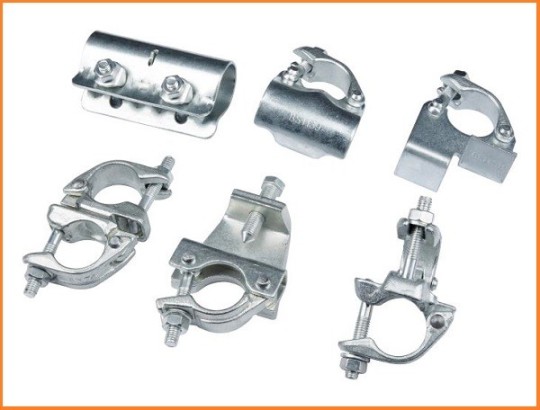
The global scaffolding accessories market is estimated to be valued at US$ 1.45 billion in 2023 and is expected to exhibit a CAGR of 5.6% over the forecast period 2023-2030, as highlighted in a new report published by Coherent Market Insights.
Market Overview:
Scaffolding accessories are vital components used in the construction industry for providing structural support and stability to workers and materials during construction or maintenance activities. These accessories include couplers, frames, braces, jacks, and boards, among others. They are essential for ensuring safety and efficiency in construction projects, especially in high-rise buildings and large infrastructure developments. The need for scaffolding accessories arises due to the requirement of a temporary working platform and secure access to elevated areas.
Market Key Trends:
One key trend driving the growth of the global scaffolding accessories market is the increasing demand for construction and infrastructure development. Rapid urbanization, population growth, and government initiatives for infrastructure development in emerging economies are fueling the construction activities worldwide. This has led to a surge in construction projects, such as residential buildings, commercial complexes, bridges, and highways, creating a significant demand for scaffolding accessories.
PEST Analysis:
Political: The political environment plays a crucial role in shaping the scaffolding accessories market. Government regulations and policies related to construction safety standards and building codes influence the demand for scaffolding accessories.
Social: The growing population, urbanization, and the need for affordable housing are social factors that drive construction activities and subsequently, the demand for scaffolding accessories.
Technological: Technological advancements, such as the introduction of lightweight and modular scaffolding systems, have improved the efficiency and safety of construction activities. Modern scaffolding accessories with advanced features are witnessing increased adoption in the market.
Key Takeaways:
1. The global Scaffolding Accessories Market is expected to witness high growth, exhibiting a CAGR of 5.6% over the forecast period, due to increasing demand for construction and infrastructure development. The need for safe working platforms and access to elevated areas drives the demand for scaffolding accessories.
2. In terms of regional analysis, Asia Pacific is expected to be the fastest-growing and dominating region in the scaffolding accessories market. Rapid urbanization, population growth, and government initiatives for infrastructure development in countries like China and India are driving construction activities, thereby bolstering market growth.
3. Key players operating in the global scaffolding accessories market include Brand Energy & Infrastructure Services, Layher Holding GmbH & Co. KG, Safway Group Holding LLC, ULMA Construction, PERI GmbH, Altrad Group, MJ-Gerüst GmbH, Waco Kwikform Limited, Turbo Scaffolding, Simplified Scaffolding Pty Ltd., Hunan World Scaffolding Co., Ltd., Tianjin Wellmade Scaffold Co., Ltd., Apollo Scaffold Services Ltd., Pilosio S.p.A., and Instant Upright. These companies focus on product innovation, strategic partnerships, and geographic expansion to gain a competitive edge in the market.
In conclusion, the global scaffolding accessories market is expected to witness significant growth fueled by the increasing demand for construction and infrastructure development. As construction projects continue to surge globally, the need for scaffolding accessories to ensure safety and provide secure access to elevated areas will drive market growth. The Asia Pacific region is expected to dominate the market, supported by rapid urbanization and infrastructure initiatives. Key players in the market are focused on innovation and expansion strategies to maintain their competitive positions.
#Scaffolding Accessories Market#Information and Communication Technology#Scaffolding Accessories Market Overview#Scaffolding Accessories Market Growth#Scaffolding Accessories Market Analysis#Scaffolding Accessories Market Forecast#Scaffolding Accessories Market Future#Scaffolding Accessories Market Key players
0 notes